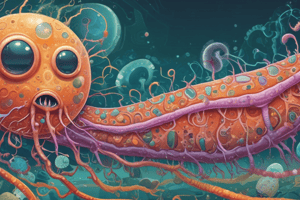Podcast
Questions and Answers
What does it mean when a fungus is described as pathogenic?
What does it mean when a fungus is described as pathogenic?
- It can metabolize sugars only.
- It can invade tissues and digest material externally. (correct)
- It can only reproduce through spores.
- It thrives only in aquatic environments.
Which of the following statements about fungal spores is true?
Which of the following statements about fungal spores is true?
- Fungal spores grow only in soil.
- Fungal spores require water to become airborne.
- Fungal spores can be inhaled and may cause infections. (correct)
- Fungal spores are diploid and do not disperse.
What characteristic defines pathogenic dimorphic fungi?
What characteristic defines pathogenic dimorphic fungi?
- They are always filamentous.
- They only cause infections in plants.
- They exist as spores only.
- They can switch forms based on temperature. (correct)
Which of the following is NOT a typical result of a fungal infection in humans?
Which of the following is NOT a typical result of a fungal infection in humans?
What type of fungi are primarily responsible for fungal infections known as mycoses?
What type of fungi are primarily responsible for fungal infections known as mycoses?
How do pathogenic fungi obtain nutrients from their host tissues?
How do pathogenic fungi obtain nutrients from their host tissues?
Which statement correctly identifies an aspect of fungal infection prevalence?
Which statement correctly identifies an aspect of fungal infection prevalence?
At which temperature does a pathogenic dimorphic fungus typically exhibit mold-like characteristics?
At which temperature does a pathogenic dimorphic fungus typically exhibit mold-like characteristics?
Which type of protozoan moves by extending cytoplasmic projections?
Which type of protozoan moves by extending cytoplasmic projections?
What is the primary method of feeding for flagellates?
What is the primary method of feeding for flagellates?
Which of the following statements about sporozoans is true?
Which of the following statements about sporozoans is true?
Which organism is an example of a sporozoan that causes malaria?
Which organism is an example of a sporozoan that causes malaria?
Which of these is a characteristic of ciliates?
Which of these is a characteristic of ciliates?
How many species of ciliates are known to be pathogenic for humans?
How many species of ciliates are known to be pathogenic for humans?
What is a definitive host in the context of sporozoan parasites?
What is a definitive host in the context of sporozoan parasites?
What differentiates sporozoans from other protozoan groups in terms of mobility?
What differentiates sporozoans from other protozoan groups in terms of mobility?
What is the primary treatment for athlete's foot?
What is the primary treatment for athlete's foot?
Which of the following is a common method of transmission for tinea corporis?
Which of the following is a common method of transmission for tinea corporis?
How can tinea unguium best be treated?
How can tinea unguium best be treated?
Which preventive measure helps in avoiding athlete's foot?
Which preventive measure helps in avoiding athlete's foot?
What description fits tinea corporis?
What description fits tinea corporis?
What is a common characteristic of tinea unguium?
What is a common characteristic of tinea unguium?
What type of clothing is recommended to help prevent ringworm?
What type of clothing is recommended to help prevent ringworm?
What is the significance of practicing good hygiene in the prevention of ringworm?
What is the significance of practicing good hygiene in the prevention of ringworm?
What is the motile, feeding, and reproducing stage of a typical protozoal life cycle called?
What is the motile, feeding, and reproducing stage of a typical protozoal life cycle called?
Which protozoal infection is primarily transmitted through ingestion or inhalation of dormant stages?
Which protozoal infection is primarily transmitted through ingestion or inhalation of dormant stages?
During which stage do protozoa provide protection against adverse environmental conditions?
During which stage do protozoa provide protection against adverse environmental conditions?
What is the typical size range of trophozoites of Entamoeba histolytica?
What is the typical size range of trophozoites of Entamoeba histolytica?
Which protozoal infection is caused by Giardia lamblia?
Which protozoal infection is caused by Giardia lamblia?
How many nuclei do mature cysts of Entamoeba histolytica have?
How many nuclei do mature cysts of Entamoeba histolytica have?
Where in the human body can Entamoeba histolytica be found?
Where in the human body can Entamoeba histolytica be found?
What best describes the relationship between the intermediate host and protozoal reproduction?
What best describes the relationship between the intermediate host and protozoal reproduction?
What is the primary habitat of Giardia lamblia within the human body?
What is the primary habitat of Giardia lamblia within the human body?
What is the method of transmission for giardiasis?
What is the method of transmission for giardiasis?
What characteristic morphology do mature Giardia cysts exhibit?
What characteristic morphology do mature Giardia cysts exhibit?
Which of the following symptoms is most commonly associated with giardiasis?
Which of the following symptoms is most commonly associated with giardiasis?
What is a significant distinguishing feature between trophozoites and cysts of Giardia lamblia?
What is a significant distinguishing feature between trophozoites and cysts of Giardia lamblia?
During which stage does Giardia lamblia replicate through binary fission?
During which stage does Giardia lamblia replicate through binary fission?
Where are Giardia cysts typically found in feces?
Where are Giardia cysts typically found in feces?
What is the primary clinical manifestation of malaria caused by Plasmodium falciparum?
What is the primary clinical manifestation of malaria caused by Plasmodium falciparum?
Flashcards are hidden until you start studying
Study Notes
Protozoa
- Protozoa are single-celled eukaryotic organisms.
- They are diverse and include amoebas, flagellates, ciliates, and sporozoans.
- Amoebas move by extending cytoplasm projections called pseudopodia
- Flagellates have whip-like projections called flagella that rotate and propel them.
- Ciliates have hairlike projections called cilia that cover the cell surface.
- Sporozoans are obligate intracellular parasites with nonmotile adult forms.
Parasitic Protozoa Infections
- Parasitic protozoan infections are often acquired by ingestion or inhalation of dormant stages.
- The life cycle of protozoa typically has two stages:
- Trophozoite: motile, feeding, and reproducing stage.
- Cyst: non-motile, dormant stage.
- Cysts provide protection during adverse environmental conditions.
Common Examples of Protozoan Infections
- Amebiasis (Entamoeba histolytica): Causes intestinal infection and can spread to liver, lungs, brain, and other tissues.
- Giardiasis (Giardia lamblia): Infects the small intestine and causes diarrhea, steatorrhea (loose, pale, fatty stools), and abdominal cramps.
- Malaria (Plasmodium falciparum): Infects red blood cells and hepatic cells.
Giardiasis
- Caused by the flagellate Giardia lamblia.
- Each cyst releases two trophozoites in the small intestine.
- The parasite attaches to the intestinal mucosa and absorbs nutrients.
- Transmission occurs through the fecal-oral route, by ingestion of cysts, or from person to person via contaminated hands.
Malaria
- Caused by the sporozoan Plasmodium falciparum.
- Found worldwide, particularly in tropical and subtropical regions.
- The parasite infects red blood cells and hepatic cells (liver).
- Diagnosis is made by identifying parasite stages in red blood cells.
Studying That Suits You
Use AI to generate personalized quizzes and flashcards to suit your learning preferences.




